Review of Substack in 2020
Takeaway
Substack’s strength and weakness lies in its simplicity. I go over a crowdsourced feature wishlist from the Type House writers telegram group, and end with thoughts on how the newsletter industry still has room to grow.
Update to 2019 review of Substack, the email newsletter service
Last year, I wrote a review of Substack that still ranks on the front page of Google. Today I want to revisit that review with new thoughts on Substack and the newsletter industry.
We’ll cover:
- Overview of Substack features
- What I’ve liked so far
- What I haven’t liked
- Crowdsourced feature wishlist
- Thoughts on the newsletter industry
1. Substack is still a simple way to start, and that counts for a lot
Email newsletters have been rising in popularity since 2019, and part of the reasons are Substack’s funding announcement, a pendulum shift back to subscription revenue, and high profile writers starting a newsletter [1].
Substack was and still is one of the easiest ways to set up a professional newsletter. By that I mean something that’s moved on from directly emailing people, which is how many people start out [2].
Some good reasons to move to a professional service like Substack include:
- Posting publicly allows discovery, sharing, and faster growth of your readership
- Access to tools to monitor readership base, such as open rates, click rates, growth over time
- More professional, better looking, and fancy formatted emails
Substack’s changed the sign up flow since I joined, so here’s a brief walkthrough of the flow and writing process:
You need an email account to create a substack account, and you need to create a substack account in order to explore the features i.e. there’s no guest preview mode.
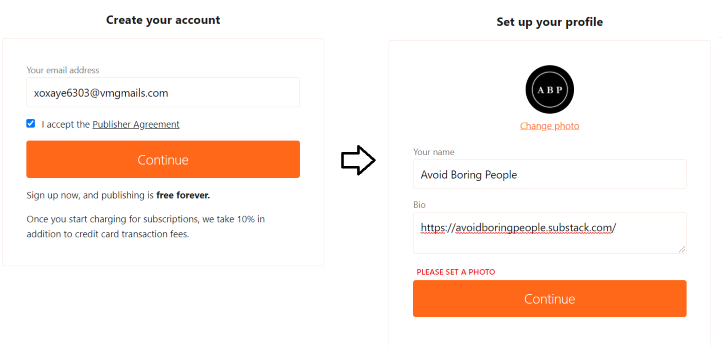
After you’ve set up a profile pic, name, and bio, the next step is to choose your publication details. After that, you can import a mailing list csv, if you already have a readership base from elsewhere.
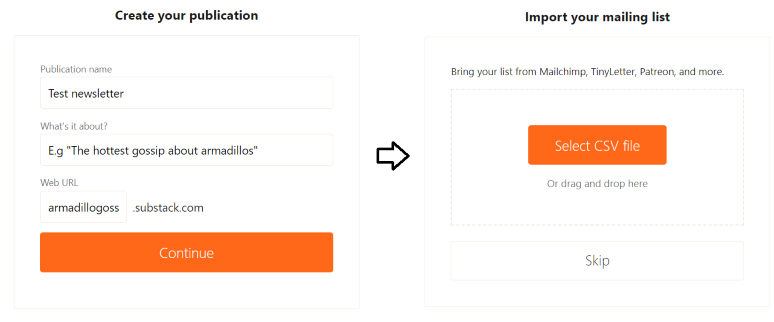
You’re now done with the basic account setup and can start posting. There’s many more advanced options to toggle in “Settings,” but that’s beyond the scope of this article [3].
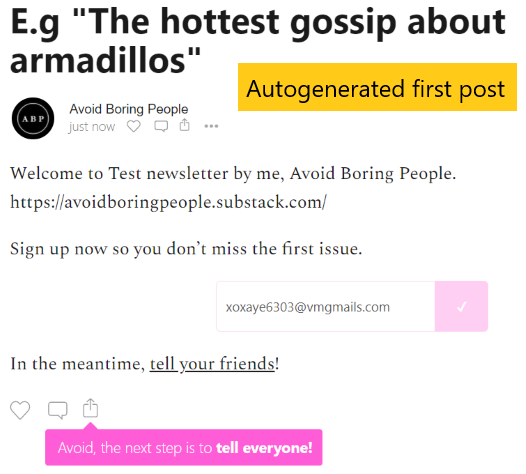
Substack automatically creates a first welcome post for you, so that the landing page for your newsletter doesn’t look completely empty.
Posting is simple as well. You go to your dashboard, click on create a new post, and that directs you to the Substack editor. The editor is largely a “What you see is what you get” editor, with standard formatting options. I’ll comment more in section 3.
Once you’re done writing, you can publish it out to your email list. There’s some options you can choose, such as scheduling the post, changing the preview, or restricting it to paid subscribers.
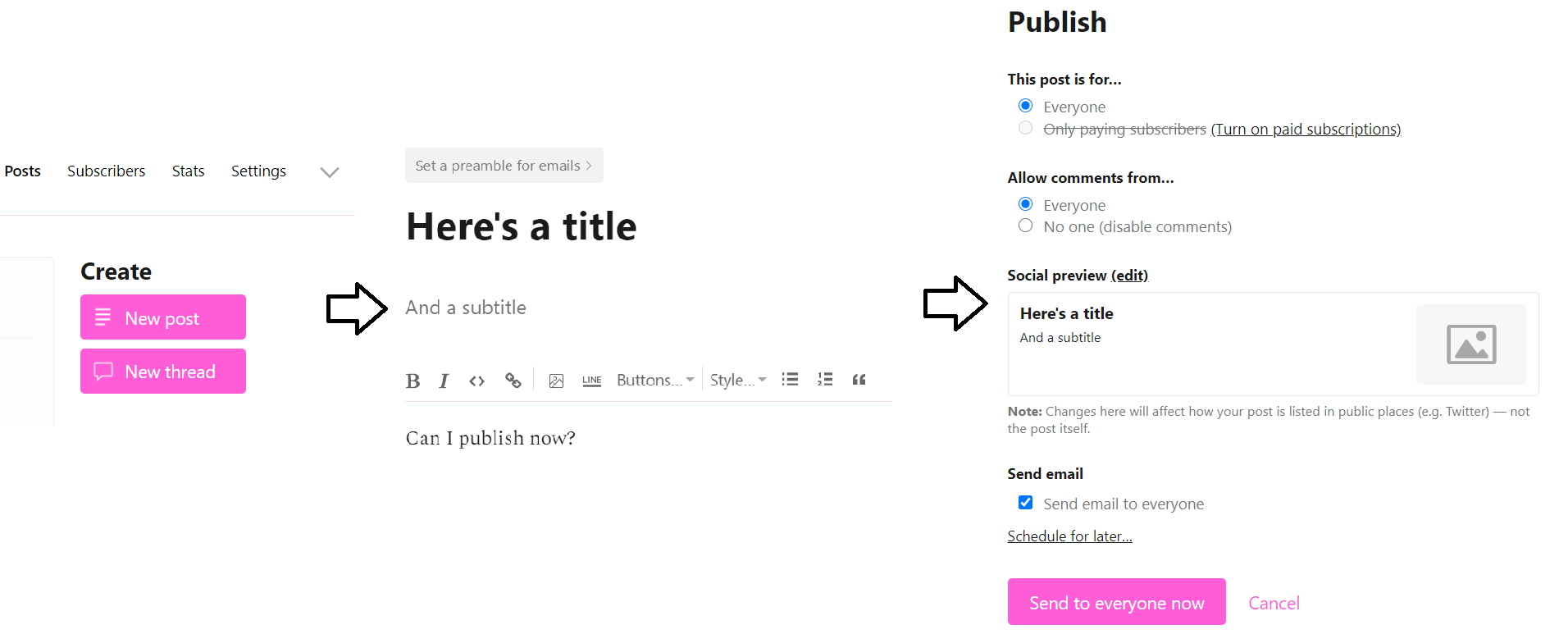
We’ve gone over writing, so let’s take a brief look at their metric dashboards as well.
The subscriber dashboard shows you your growth over time, in terms of rev, paid subscribers, and free subscribers. If also shows you a list of every sign up and if they had any recent activity such as opening or clicking on your email.
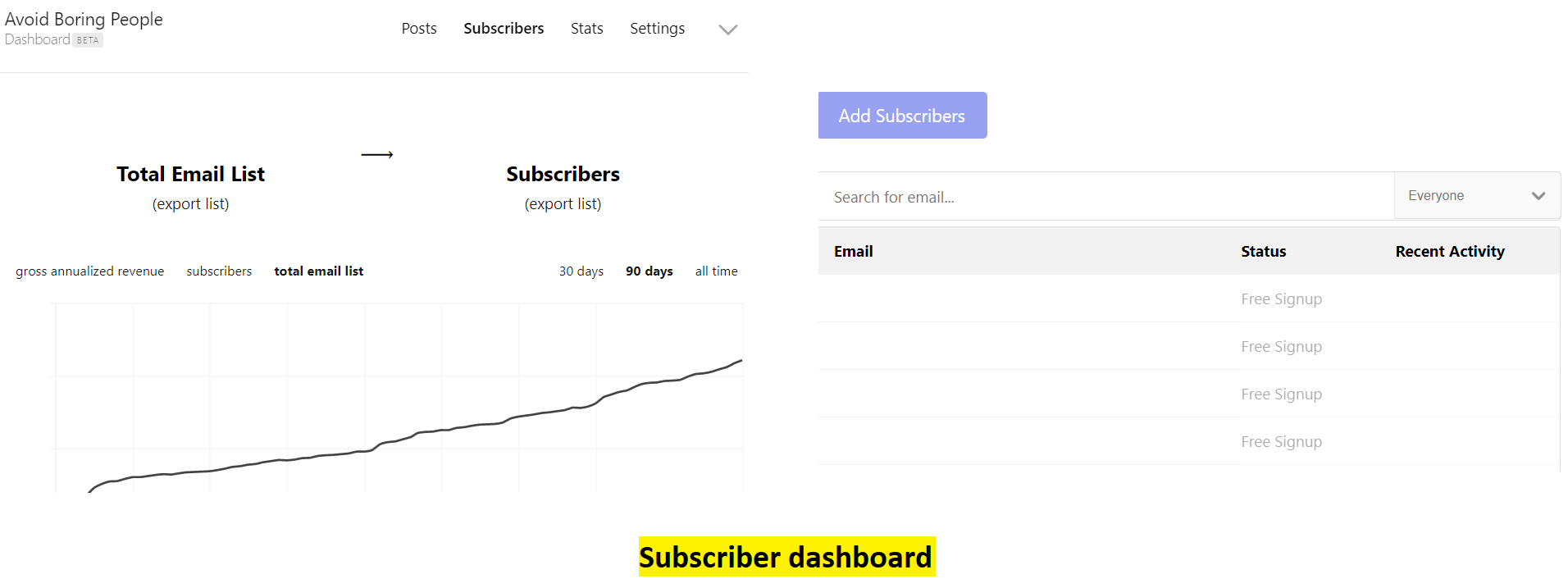
The stats dashboard shows you traffic. The main graph shows visitors to your substack website over time. There’s also a table that roughly tracks the source of that traffic, which can be helpful if you realise there’s an unusual source of traffic that might be worth looking into.
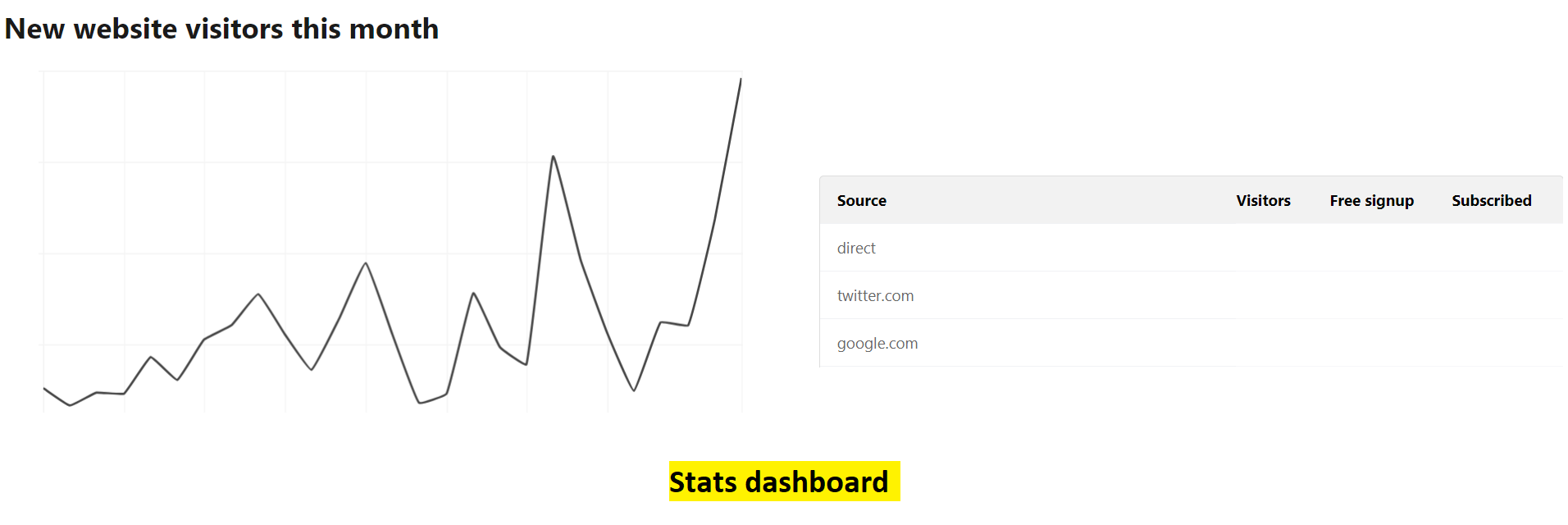
That’s a brief overview of the platform, now on to things I like and dislike.
2. Substack’s strength in simplicity
Substack’s big strength is the simplicity of setup and sending your first email. I’ve seen people suggest Ghost as a more feature-filled alternative. While that’s true, these people are missing the point. Substack is awesome because I can just follow the steps above and start sending emails. I can’t do that on Ghost, which takes much more work to set up. I’ve seen people ask for consulting or implementation help in moving to Ghost, but people don’t need to ask for help in moving to Substack, because the interface of the latter is straightforward [4]. While it’s true that migrating to Ghost eventually could make sense, for many people there’s less need to start on it.
Substack is free unless you start charging readers. This is a different strategy vs Ghost, Revue, or Mailchimp. Revue and Mailchimp have free tiers, but start charging past a certain number of subscribers. Ghost only has a free trial. Actual cost of sending email is cheap, so Substack is using its paid writer base to subsidise its free writer base, whereas the other providers are effectively doing the opposite. This is another way Substack is beginner friendly.
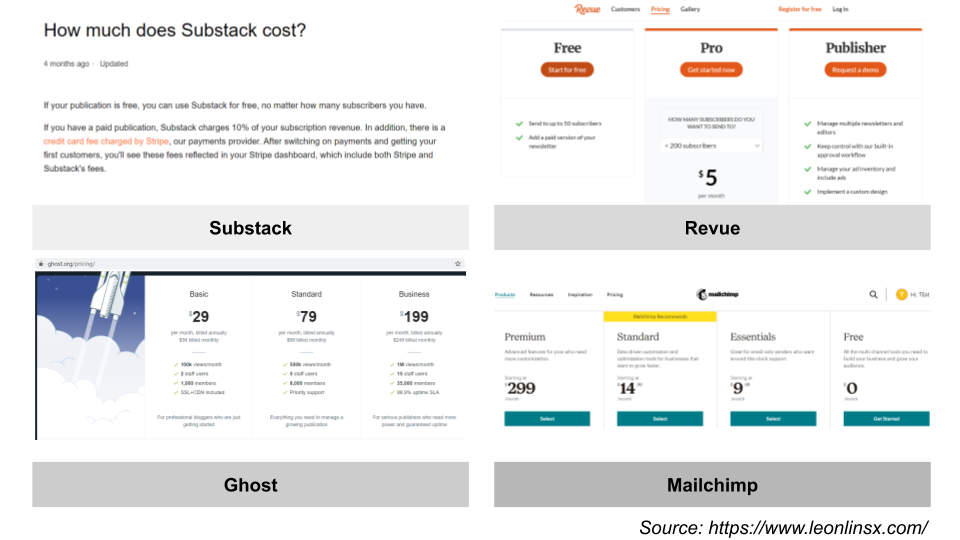
Substack gives you a simple website with comment functionality and archives. Not needing to set this up separately also lowers the barrier to starting. Again, a lot of this can be recreated with some of the competition. It’s just easier on Substack.
Some other smaller things I’ve liked include the ability to import/export subscriber lists, create different paid subscription offers, and the popup asking people to subscribe before reading [5].
3. Substack’s weakness is also in simplicity
Writers that will make Substack money are going to want more. I touch on a crowdsourced wishlist in the next section. Substack is beginner friendly, but they can only make money from writers who put up a paywall. Such writers are usually not beginners anymore, and want a lot more features for their needs. Substack will increasingly have to cater to these writers, making decisions that don’t help beginners.
Support is swamped. Understandably given the small team, getting support from Substack on any issue is difficult. Case in point - they created a knowledge base to reduce the amount of inbound support requests, as well as a status page for people to see if Substack’s down. Notice that there’s no contact email anywhere [6].
Anecdotally, I experienced a bug with the editor the night before I wanted to send a post. The knowledge base and status page weren’t helpful since this was clearly something that broke accidentally. I tried reaching out over twitter and an old welcome email but didn’t hear back in time, and only managed to get in touch because I knew someone that knew someone. My post was delayed as a result.

I do have other dislikes, but a lot of them will be implied from the wishlist, so let’s get to that.
4. Top features requested include custom domains, better pricing, and more help with audience growth
I’m part of a business writers telegram group called Type House, and the group’s overall wishlist is below:
Custom domains. Writers want to build their brand, not Substack’s.
Better pricing. Remember earlier when I said the free pricing was a strength? It’s great to get people to start, and the problem now is that Substack needs to make up the revenue somewhere else. In this case, the 10% take rate they charge. This doesn’t sound high, but actually is once you start doing the math vs competitors. Add on the Stripe fees [7] and you might be paying 20%+ on what you charge your readers.
Some suggestions from the group on this included switching from variable fees to fixed fees once the writer had reached a certain size, and easier facilitation of group subscriptions.
Help in growing audience. Most writers want to continue growing their readership. Substack is starting to help here, with scholarship programs, writer features, and twitter connections. However, the fact that so many newsletter directories have popped up [8] means that discovery is still an unsolved problem.
Some suggestions included better SEO in general, referrals program, and more marketing of unknown writers.
More features for the editor. This goes back to the point of who the ideal Substack writer is. They’d have a large audience and also need more features.
Suggestions included shareable links to subsections rather than the entire article [9], font customisation, page text width, image captions, better footnoting functions with bidirectional link or popup boxes, URL customisation, more media embeds (particularly Tik Tok), and whitespace.
Better audience management. The subscribers and stats dashboards I showed above are lacking compared to competitors. I’d want to segment my readership different ways, to identify most loyal readers and also who might be at risk of churning. There’s not enough info on Substack now for that.
Suggestions included a “biggest fans” feature to show who drove the most opens over a time period, identifying inactive subscribers for reminder emails, plus churn and cohort analysis.
Some other suggestions included better site reliability and uptime, working with Gmail so that posts end up in Primary, health insurance, and API access.
That’s all we had, and I’ll end with a recap and quick thoughts on newsletters.
5. Newsletter industry is still early, and publishing consistently is going to be the biggest hurdle
I’ve written multiple posts about newsletters in the past few years, and my general views haven’t changed significantly:
- Having a direct relationship with your audience is awesome
- Decreased cost, increased control, increased convenience has led to the rise of newsletters
- We’re still early in this trend, and there’s a large market for newsletters in niches
- Writing is difficult. Writing consistently and publishing regularly is going to be tremendously tough for most. People severely underestimate the difficulty of writing regularly. Many newsletters are going to turn into occassional issues without a schedule, at which point they’re essentially a blog
- Valuation multiples for newsletters aren’t great, especially with key man risk
Substack still needs to figure out what they want to be. They’re great for beginners to get started, but only make money from scaled writers. There’s little help provided to get the beginners to that stage, and if they do the fees are high.
The good news is that Substack is still so young and they have time to figure this out. Writing is not going to go away, and Substack has a role to play in reducing friction for people who want to write.
Credit to Lenny Rachitsky, Li Jin, Josh Constine and all the other members of the Type House writer’s group for the feature wishlist
Footnotes
- For example, Casey Newton of the Verge, Polina Marinova of Term Sheet, or Josh Constine of Techcrunch all started newsletters on substack
- Myself included, which is a story for another time. I started off with 8 people in my mailing list, not even bccing people, and less structure
- There’s a lot of stuff you should adjust in Settings, so it’s worth going through that page carefully. For example, setting up analytics, ensuring all your welcome emails are the same, or adjusting email notifications
- For simplicity I’m going to ignore the custom deals that Substack arranges with top writers to poach them.
- I’ll acknowledge that popups before reading are annoying. They work though so…
- There used to be a support@substack.com listed somewhere but it’s now become difficult to find
- Stripe charges both a percentage and a fixed amount, so it’s especially painful if you’re only charging people a small amount monthly.
- Such as pigeonnewsletters, findnewsletters, newsletterstack to name a few. There’s at least 20 last I checked.
- “sub-heading URLs so you can share different segments of a newsletter with a different image, headline, body preview on Twitter etc”
If you liked this, sign up for my finance and tech newsletter: